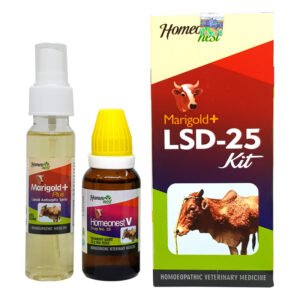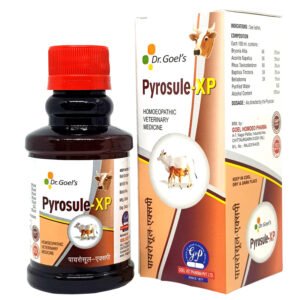
A U-Turn For Uterine Problems: Keeping Uterine Problems At Bay
Our lives are closely intertwined with those of other creatures around us. We are all in a circle of life where one creature inevitably depends upon another. This is termed symbiosis- to live in union. One such beautiful example of co-dependency is our relation with the livestock – the cows and buffaloes. We get milk, and we process products from milk such as cheese, paneer, ghee, etc. all of this is possible because of our close connection and co-relation with cows and buffaloes. They have played a crucial role in our lives since time immemorial. On the flip side, we provide them with food, shelter, care, and medicine as required. This is a beautiful example of a symbiotic relationship. In today’s blog, let’s have a look at various uterine problems that cows or buffaloes may face and ways through which we can help them.
THE HARMONY OF HORMONES
Hormones are chemicals that all living beings have, and they play an essential role in regulating various processes in our bodies. Hormones are integral in so many of your body systems, and they regulate a lot of what your body does. Medically, hormones are defined as chemical substances that act like messenger molecules in the body. After being made in one part of the body, they travel to other parts of the body, where they help control how cells and organs do their work.

Here are a few examples of hormonal roles in our body:
- Hormones regulate the growth of the body via growth hormones.
- They aid in sexual functions, right from conception to parturition [birth giving] also, they aid in lactation [milking young new-born babies]
- Hormones play an important role in regulating metabolism via thyroid hormones, etc.
- They also aid in various body systems such as the digestive system, the immune system, the urinary system, the cardiovascular system, and the respiratory and skeletal systems.
In fact, all our organs, tissues, and cells are inevitably dependent upon hormonal harmony. Hormones thus help our bodies to function normally, and properly in perfect union with other hormones. Of course, as mentioned above, these hormones or chemical messengers play an extremely crucial role in uterine problems and their solutions.
Let’s have a look at some of the common uterine problems-
Uterine Problems: Unexpected Challenge
The uterus is an organ that is present in the female reproductive tract. It is the female reproductive organ that receives the fertilized egg and supports its development during pregnancy. The main function of the uterus is to protect, grow and nourish the developing foetus prior to birth. There are many challenges a farmer could face while rearing livestock for milk and milk products. Major ones include retention of placenta post-birth, habitual abortion, delivery complications, retention of placenta, metritis, pyometra, etc.
1. Retention Of Placenta
The natural birthing process involves the delivery of the foetus and expulsion of the placenta and other connections, foetal membranes from the uterus. The placenta is a temporary organ that develops in the uterus during pregnancy. This structure provides oxygen and nutrients to the growing foetus and removes waste products from the foetal blood. The placenta attaches to the wall of the uterus and is generally expelled out of the body post-birth.
Normally the placental expulsion takes place within 3-8 hours after delivery of the calf.
Retention of the placenta implies that the placenta, which normally should have been expelled out naturally after the birthing process, hasn’t been expelled out. The reason could be the inability of the uterus to contract efficiently, or it could be a sequel to uterine inertia [due to labor stages which lasted for a longer time-span causing the uterus to get tired] or it could be due to premature birth and abortion. Other causes include advancing age of the cow, various nutritional disturbances and inflammation of the placenta, etc
2. Abortions
Abortion is the termination of a pregnancy by removal or expulsion of an embryo or foetus. It could be because of several reasons like- various bacterial infections such as brucellosis, listeriosis, leptospirosis or viral infections such as bovine viral diarrhea virus, bluetongue virus, toxins, dietary deficiency of Vitamin A, vitamin E, selenium, and iron. Also, severe stress or environmental stress could eventually lead to abortion. High maternal temperature due to fever may be one of the important factors which induce heat stress.
3. Uterine Infections: Pyometra, Metritis, Etc.
Uterine infections such as pyometra or metritis are very important to be noted as they may further complicate the life of the cow. Pyometra is a chronic inflammatory condition of the uterus wherein the uterus is filled with pus. Pyometra is a secondary infection that occurs as a result of hormonal changes in the female’s reproductive tract. There are two types of pyometra:
A] OPEN PYOMETRA: pus will drain from the uterus through the vagina to the outside. Pus or an abnormal discharge is often seen on the skin or hair under the tail or on bedding
B] CLOSED PYOMETRA: If the cervix is closed, pus that forms is not able to drain to the outside. The bacteria release toxins that are absorbed into the bloodstream.
The factors which pre-disposes the female to pyometra are but are not limited to:
- ABORTION
- PREMATURE BIRTH
- TWIN BIRTHS
- RETAINED PLACENTA
- SEPTIC METRITIS
- POST-PARTUM METRITIS
- UNHYGIENIC CONDITIONS
- INFECTIOUS AGENTS
This increases the chances of invasion of pathogenic bacteria inside the uterus, and their chances of multiplication, too, increase.
Similarly, metritis is the inflammation of the uterus, which again could be related to bacterial-viral etiologies, abortion, or retained placenta. Yes, all of these conditions could be closely linked to each other.
Diagnosis: An Essential Key To Treatment
It is very important to understand why milk production has gone down or why your cattle are unthrifty. The reasons for conception failure, lower milk yield, and frequent abortions could be any, and hence these conditions must be diagnosed at the earliest. The diagnosis, however, depends upon multiple factors. The following three steps are essential to diagnose efficiently:
- Clinically relevant History
- Laboratory results and testing [USG etc.]
- Per-rectal exam
1. History Taking
Your veterinarian may ask clinically relevant questions and try to filter out relevant History. Thus, let’s look into the signs/symptoms which may be observed:
SYMPTOMS
- Permanent or intermittent purulent discharge is observed by the farmer/owner
- Cyclic estrous activity may/may not be present [irregular interval]
- Anorexia
- Decrease in milk production
- Dullness/listlessness seen
HISTORY: your vet may ask you-
- About the age of the animal
- The date of insemination must be noted
- Cyclicity date/frequency to be noted
Per-Rectal Exam
On per-rectal examination, your vet might be able to diagnose the Cyclicity, pregnancy stage, etc., cervix, corpus luteum persistence, uterine wall thickness, etc., which may be palpated and noted. In fact, even early-midterm pregnancy can be diagnosed. This helps us to rule out or rule out the possibility of a wide range of uterine problems.
Uterine: Endometritis Treatment in Cattle
Treatment: An Easy Solution
The treatment approaches must be aimed at treating the root cause rather than treating symptoms. Thus, an established diagnosis is important. Your vet may suggest some remedies such as-
1. Dietary Fix
Diet plays an important role in modulating immunity and health. Thus, a few small changes in diets can help. Better-fed cows have higher fertility and an improved conception rate. A good amount of carbohydrates, fats, essential fatty acids, and essential minerals like iron, etc. play a pivotal role in reproductive health. In fact, even vitamins are important in this aspect.
2. Hormonal Therapy
Hormone injections of implants or ear tags could be used to keep in check the balance and Cyclicity of the patient. It’s important to note that hormonal therapy must be initiated or stopped, or regulated under the guidance of a veterinary doctor as these hormones affect the reproductive health as well as various body systems and thus affecting milking, milk yield, and overall health of the cow/buffalo.
3. Non-Hormonal Therapy: Homeopathic Approach
One such novel approach through non-hormonal therapy is homeopathic medicine- Uterogen. The success of pregnancy facilitated by easy parturition depends on the hormonal balance and their regular release. During pregnancy, hormones work on the principle of the check and release phenomenon. It is important that this phenomenon or process is maintained so that all the necessary hormones are activated at the right time. So the entire period between conception and delivery is physiologically balanced by the hormones. The possibility of any type of complication or inconvenience during parturition (delivery) should be minimum, and the tonicity of the uterus should be maintained. Uterogen is a non-hormonal formulation that regulates the hormones concerned with pregnancy. Uterogen regulates and balances the Progesterone levels to make the pregnancy safe. Nearing the delivery, it excites the complete process of parturition by reducing the Progesterone levels and increasing the Oxytocin levels with the help of the Pituitary gland, which stimulates and produces the Oxytocin hormone. Oxytocin, with the help of the Gonadotropic hormone, completes the process of parturition and later stimulates the prolactin hormone so that there is a normal milk yield. Uterogen mediates this complicated process as a non-hormonal indicator and catalyst. In this way, all the hormones are released one after another as per the cycle automatically.
“A MULTI-PURPOSE UTERINE REMEDY” UTEROGEN regulates the process of pregnancy till delivery. Therefore the risk of abortion is minimized. Other conditions for which this remedy can be used are:
- Uterogen helps with safe delivery.
- Uterogen maintains the hormonal tonicity of the uterus resulting in the release of hormones sequentially as required.
- Uterogen is helpful in expelling the placenta, decreasing the possibility of metritis or pyometra, curing the complications of delivery and avoiding infections.
Thus, there might be some instances where your cow might face uterine problems, which could lead to dropping in milk yield, abortions, health issues, and infections, but these are easily curable and preventable by adopting simple approaches, changing diet, antibiotics for infectious causes [metritis, pyometra, etc.] or by hormonal therapy or via novel homeopathic remedies. Let us show a U-TURN to all uterine problems by being vigilant and adopting good rearing practices.
Homeopathic Solutions For Cow and Buffalo
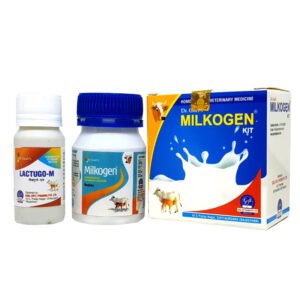 MILKOGEN KIT for Increasing Milk in Punganur Cow
MILKOGEN KIT for Increasing Milk in Punganur Cow
MILKOGEN Kit is an excellent Homeopathic Veterinary Medicine used in Cows and Buffaloes to increase milk yield naturally. It is a natural replacer of oxytocin hormone without any contraindications or side effects but with a definite increase in the milk yield. It increases the milk quantity and fat percentage of the milk to the full potential of an animal.
TEATASULE FIBRO GOLD KIT For Mastities Issue In Punganur Cow
TEATASULE FIBRO GOLD KIT is the best Homeopathic Veterinary Medicine for female animals in the case of chronic and clinical mastitis. TEATASULE FIBRO GOLD KIT is very effective in case of chronic or clinical mastitis when the udder is as hard as a stone, teats are shrunk with fibroids developed in the teats, and in teat cracks.
Marigold+ LSD-25 Kit For Lumpy Skin Diseases
Marigold+ LSD-25 Kit is For boosting immunity against LSD and other similar viral diseases. It is a Homeopathic Treatment of Lumpy Skin Disease (LSD) in cattle with oral medicine for enhancing internal Immunity and Healing Spray for treating external wounds.
Pyrosule-XP for High Fever in Cattle
PYROSULE-XP for CATTLE is the best Homeopathic Veterinary Medicine for Cattle that protects animals from infection. PYROSULE-XP relieves muscular and nervous pain that occurs during a fever and even decreases the severity of the fever.
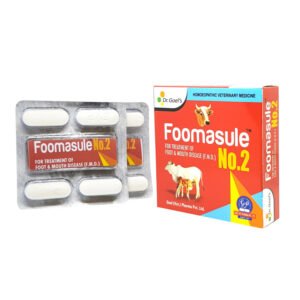 FOOMASULE NO. 2 for Foot and Mouth Disease
FOOMASULE NO. 2 for Foot and Mouth Disease

ProlapsGo For Prolaps Problem In Cattle
PROLAPSGO for cattle is the best Homeopathic Veterinary Medicine for Pre-partum or Post-partum prolapse of the uterus in cows & buffaloes. PROLAPSGO gives fast and long-lasting relief in case of prolapse of the uterus in cows and buffaloes. It can be sprayed directly over the prolapse of the uterus and can also be administered orally.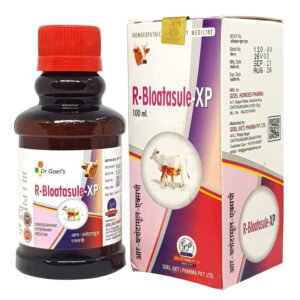
R.Bloatasule-XP For Bloating Issue in Cattle
R. BLOATASULE XP is the best Homeopathic Veterinary Medicine that is helpful for the treatment of indigestion, anorexia, and liver disorders.Check out: – GOHEAL SPRAY
Check out: – HEMISEPT for CATTLE – 100ML










